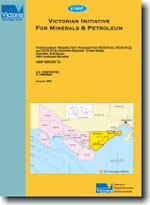VIMP Report 70 - Hydrocarbon prospectivity for VIC/O-01(1), VIC/O-01(2) and VIC/O-01(3), eastern onshore Otway Basin: 2001 Acreage Release
 |
| |||||
Product description:Download The downloadable version of this report is supplied in PDF format. Executive Summary In September 1998, a major fire at the Longford processing plant in East Gippsland left Melbourne with only two weeks emergency supply of gas. This incident brought home the vulnerability of the gas system due to its reliance on the Gippsland Basin, and has led many petroleum exploration companies to re-evaluate the neighbouring Otway Basin which has long been thought to have little potential. This view, however, has now been finally laid to rest with the recent discovery by SANTOS of five onshore gas fields at Port Campbell and two large (500 BCF – 1 TCF GIP) offshore gas fields to the south by an Origin Energy - Woodside Energy led joint venture. In light of these discoveries, the State of Victoria has decided to release the following three blocks in the onshore Eastern Otway Basin for work programme bidding: VIC/O-01(1), VIC/O-01(2) and VIC/O-01(3). The three blocks cover a combined area of 5473 km˛ and are located approximately 100 km southwest of the City of Melbourne (population 3,680,000), the state capital of Victoria. Examination of geological and seismic data from VIC/O-01(1), VIC/O-01(2) and VIC/O-01(3) suggests that parts of these blocks may have good hydrocarbon potential as they possess many of the prerequisites necessary for successful exploration including mature source rocks, good reservoir – seal pairs, and numerous potential structural and stratigraphic traps. Four major play types are recognised:
The three blocks on offer this year have been explored in the past by a number of companies who sunk a total of twenty one wells without encountering any significant hydrocarbon shows or accumulations. This lack of success, however, is not considered a true reflection of the prospectivity of the area because the majority of wells were sunk well before the first seismic lines were acquired in 1960 and were not valid structural tests. The first fourteen wells were spudded between 1923 and 1948 (Anglesea-1, -2; Torquay-1, -2, -3, -4, -5, -6, -7; Geelong Oil Flow-1), followed by two more in 1962 (Anglesea-1A) and 1970 (Hindhaugh Creek-1), and a further seven between 1982 and 1996 (Olangolah-1, Stoneyford-1, Tirrengowa-1, Nalangil-1, Ingleby-1, Warracbarunah-2, Irrewarra-1). The first sixteen are all located in a small corner of the basin near Anglesea. Anglesea-1 and -2, Torquay-1, -2, -3, -4, -5, -6 and –7, and Geelong Oil Flow-1 were all shallow (< 625 m deep) wells but none were valid structural tests. Anglesea-1A and Hindhaugh Creek-1 were deep wells (2371 to 3068 m deep) but neither was located on valid structures due to poor seismic control. The other seven wells are all located in the west of the area near Colac except Olangolah-1, which is located on the crest of the Otway Ranges. Of the seven, only Stoneyford-1, Tirrengowa-1, Nalangil-1, Ingleby-1 and Irrewarra-1 were valid structural tests. These wells are thought to have failed because they are located in areas of significant Mid-Cretaceous uplift and erosion, and either leaked in response to the uplift (eg. Stoneyford-1, Tirrengowa-1) or lacked access to charge from Tertiary kitchens (eg. Nalangil-1, Ingleby-1, Irrewarra-1). The other two wells, Olangolah-1 and Warracbarunah-2, were stratigraphic tests. Bibliographic reference Constantine, A.E. & Liberman, N., 2001. Hydrocarbon prospectivity for VIC/O-01(1), VIC/O-01(2) and VIC/O-01(3), eastern onshore Otway Basin, Victoria, Australia: 2001 Acreage Release. Victorian Initiative for Minerals and Petroleum Report 70. Department of Natural Resources and Environment. | ||||||

